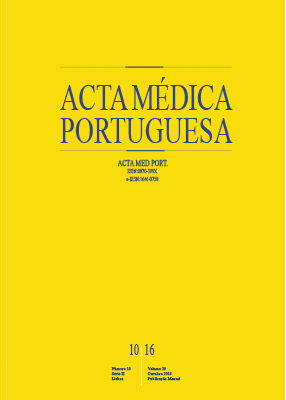Epidemiological and Demographic Characteristics of Patients with Head and Neck Tumours in the Northern Portugal: Impact on Survival
DOI:
https://doi.org/10.20344/amp.7003Keywords:
Head and Neck Neoplasms/epidemiology, Portugal, Risk Factors, Socioeconomic Factors.Abstract
Introduction: In Portugal there are still no epidemiological and demographic studies conducted in patients with of the head and neck tumors. The objectives of this analysis are to describe the epidemiological and demographics of patients with malignant tumors of the head and neck referred to an Ear, Nose and Throat department of an oncology center in the North of Portugal and also assess the impact of these characteristics on survival.
Material and Methods: Retrospective study of patients referred between January 2011 and December 2013 to the Ear, Nose and Throat Department of an oncology center (Instituto Português de Oncologia do Porto),. Five hundred sixty six patients were included. The analyzed variables were the anatomical location of the tumor, staging, gender and age of patients, the district of origin, the alcohol and tobacco consumption, educational level, occupation, marital status and family structure.
Results: The 566 patients studied (498 men and 68 women) presented a mean age of 58.1 ± 12.2 years. The majority (80.5%) were referenced in advanced stage of disease (III and IV). Seventy eight per cent of patients had moderate or excessive alcohol consumption and 69% were smokers. The vast majority of patients (82.3%) had only basic education. Patients with tumors of the hypopharynx and excessive drinking habits were referenced in more advanced stages and had a poorer survival (p < 0.001). Married patients were referred at earlier stages (p = 0.020) and patients without family support had poorer survival (p = 0.030).
Discussion: Epidemiological data are in agreement with the international literature. The high rate of patients referred with advanced stage of disease can be attributed to the patient´s delay in seeking medical care or by factors inherent to the referral system. Surveillance and family support play a key role in early referral and survival of these patients.
Conclusion: This study features a population profile that can benefit from a higher degree of surveillance, awareness campaigns and/ or screenings. Some of the variables can significantly influence the tumor stage and survival.
Downloads
Downloads
Published
How to Cite
Issue
Section
License
All the articles published in the AMP are open access and comply with the requirements of funding agencies or academic institutions. The AMP is governed by the terms of the Creative Commons ‘Attribution – Non-Commercial Use - (CC-BY-NC)’ license, regarding the use by third parties.
It is the author’s responsibility to obtain approval for the reproduction of figures, tables, etc. from other publications.
Upon acceptance of an article for publication, the authors will be asked to complete the ICMJE “Copyright Liability and Copyright Sharing Statement “(http://www.actamedicaportuguesa.com/info/AMP-NormasPublicacao.pdf) and the “Declaration of Potential Conflicts of Interest” (http:// www.icmje.org/conflicts-of-interest). An e-mail will be sent to the corresponding author to acknowledge receipt of the manuscript.
After publication, the authors are authorised to make their articles available in repositories of their institutions of origin, as long as they always mention where they were published and according to the Creative Commons license.









